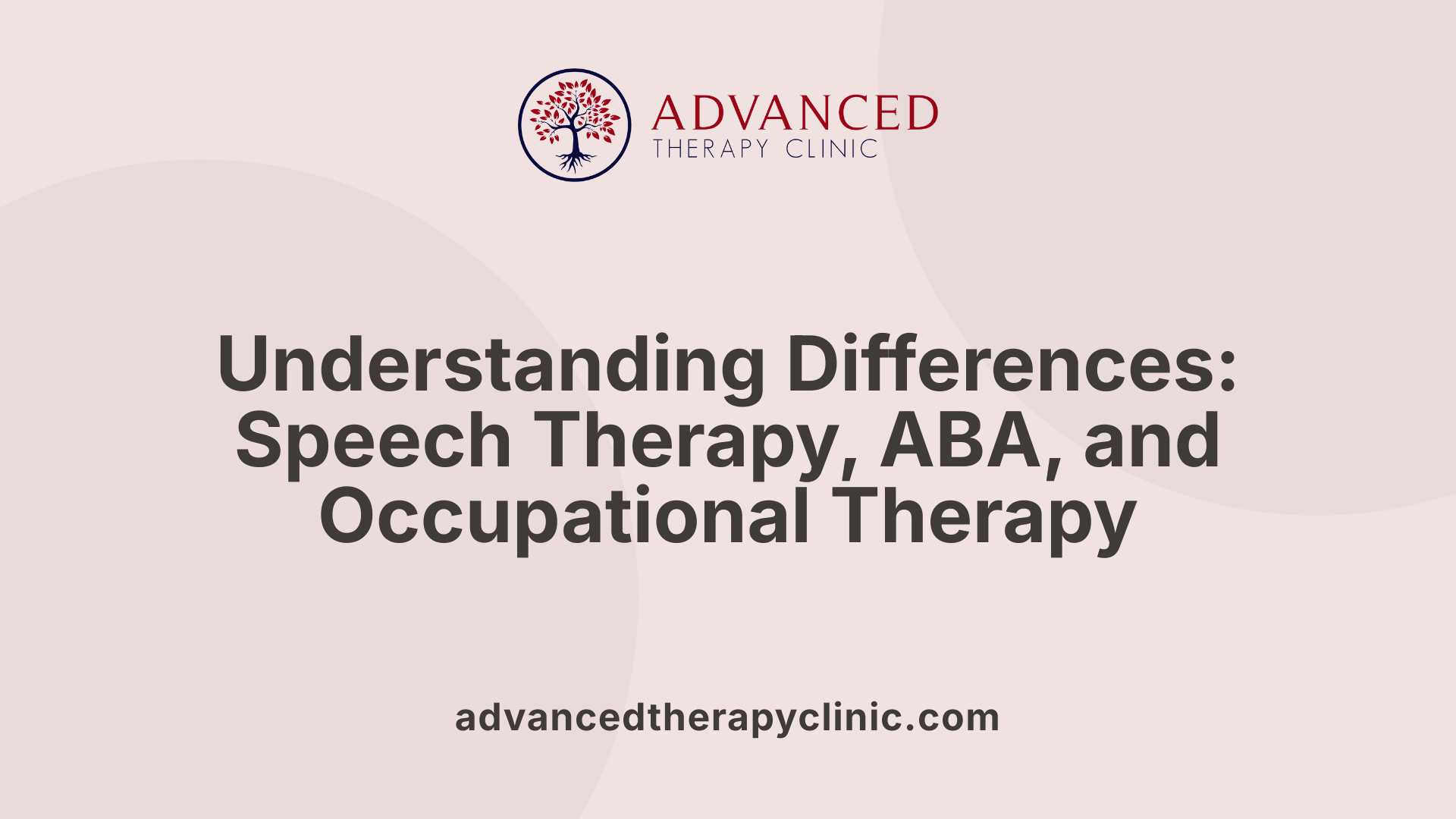Types of Speech Therapists


Understanding the Scope of Therapy-Related Fields
Therapy-related fields encompass a broad spectrum of specialties aimed at improving mental, emotional, behavioral, and physical health. Among these, speech therapy stands out as a crucial domain focused on communication and swallowing disorders. This article delves into the types of speech therapists, their roles, education, and how they work collaboratively within the expansive rehabilitation therapy framework to provide holistic care.
Overview of Therapy-Related Fields Including Speech Therapy
What therapies are commonly included under the collective term for therapy-related fields?
Therapy-related fields cover a diverse range of mental, behavioral, and physical health professions. This collective term generally includes licensed clinical social workers (LCSWs), licensed professional counselors (LPCs), licensed mental health counselors (LMHCs), marriage and family therapists (LMFTs), psychologists, psychiatrists, and psychiatric nurses. These professionals mostly focus on psychotherapy and mental health issues.
Types of therapies included
Therapies in these fields can be broadly categorized into “talk” and “doing” therapies. "Talk" therapies involve psychotherapeutic approaches such as Dialectical Behavior Therapy (DBT), Cognitive Behavioral Therapy (CBT), Acceptance and Commitment Therapy (ACT), psychodynamic therapy, Eye Movement Desensitization and Reprocessing (EMDR), family therapy, and addiction counseling. These are provided by licensed mental health professionals.
On the other hand, "doing" therapies emphasize functional and performance-based rehabilitation. Occupational therapists (OTs), physical therapists (PTs), speech-language pathologists (SLPs), recreation therapists, and massage therapists specialize in helping individuals improve physical, motor, communicative, and daily living skills.
Within "doing" therapies, specialized services include hand therapy, sensory supports, pelvic floor therapy, vestibular therapy, lymphedema therapy, feeding therapy, sports rehabilitation, sleep therapy (including CBT-I), and chronic pain management. These focus on improving specific physiological functions and are primarily delivered by OTs and PTs.
Connection between speech therapy and other therapies
Speech therapy, provided by speech-language pathologists (SLPs), is an integral part of the interdisciplinary therapy landscape. SLPs diagnose and treat communication disorders such as apraxia, aphasia, stuttering, articulation issues, and swallowing difficulties. They work closely with occupational and physical therapists, especially in cases like stroke rehabilitation, where PTs address mobility, OTs help with daily living activities, and SLPs focus on speech and swallowing.
Together, these therapy disciplines form a comprehensive care team delivering holistic health improvements tailored to the individual's needs. This integrated approach ensures that mental, functional, and physical aspects of recovery and development are addressed in a coordinated manner.
Speech-Language Pathologists: Roles and Specializations
What Are the Focus Areas of Speech-Language Pathology?
Speech-language pathologists (SLPs), commonly known as speech therapists, specialize in evaluating, diagnosing, and treating communication and swallowing disorders. Their work extends to disorders of speech sound production, language development, fluency, voice, and cognitive-communication impairments. They also address difficulties with swallowing and upper aerodigestive functions.
SLPs work closely with individuals across the lifespan—from children with delayed speech or language acquisition to adults recovering from neurological injuries affecting communication or swallowing.
Which Disorders Do Speech Therapists Treat?
Speech-language therapists provide tailored interventions for an array of disorders, including:
- Apraxia: Motor planning difficulties impacting speech production.
- Aphasia: Language impairments often following stroke or brain injury.
- Swallowing difficulties (dysphagia): Affecting safe and efficient eating or drinking.
- Fluency disorders: Such as stuttering.
- Articulation disorders: Challenges in producing specific speech sounds correctly.
- Late talkers: Children with delayed onset of spoken language.
These targeted treatments help improve individuals’ ability to communicate effectively and safely carry out swallowing.
What Types of Therapy Interventions Are Provided?
Speech therapy typically involves personalized treatment plans that may include:
- Speech sound therapy: To correct articulation and phonological errors.
- Language intervention: Enhancing expressive and receptive language skills.
- Swallowing therapy: Exercises and strategies to improve swallowing safety.
- Fluency shaping and stuttering modification: Techniques to manage fluency disorders.
- Cognitive-communication therapy: Addressing attention, memory, and problem-solving skills impacted by neurological conditions.
Therapy sessions are commonly scheduled two to three times per week, lasting about 30 to 45 minutes each, providing progressive improvement in communication and swallowing abilities.
Educational Requirements and Credentialing for Speech Therapists

Education Needed to Become Speech Therapists
To become a speech-language pathologist (SLP), individuals typically need to earn a master's degree in speech-language pathology or a closely related field. This advanced education provides in-depth training on communication and swallowing disorders, preparing graduates to evaluate and treat a wide range of speech delays, fluency issues, and language impairments.
Licensing Exams and Certification Processes
After completing their academic program, aspiring SLPs must pass the Praxis Examination in Speech-Language Pathology, administered by the American Speech-Language-Hearing Association (ASHA). This exam ensures candidates meet national competency standards.
Additionally, SLPs must obtain state licensure to practice legally. Requirements may vary between states but generally include completion of a supervised clinical fellowship and compliance with ongoing continuing education.
Professional Standards in Speech-Language Pathology
Speech therapists adhere to strict professional standards to maintain quality care and client safety. Certification from ASHA, known as the Certificate of Clinical Competence in Speech-Language Pathology (CCC-SLP), is highly regarded. It reflects adherence to ethical guidelines and commitment to best practices.
Maintaining certification requires participating in continuing education to stay current with advances in diagnosis, treatment methods, and research in communicative disorders.
| Aspect | Details | Notes |
|---|---|---|
| Education | Master's degree in Speech-Language Pathology | Foundational training for clinical competencies |
| Licensing Exam | Praxis Examination by ASHA | Required for certification and state licensure |
| State Licensure | Varies by state, typically includes clinical fellowship | Legal requirement for practicing within each state |
| Certification | CCC-SLP from ASHA | Validates professional standards and ongoing education |
This rigorous education and credentialing process ensures that speech therapists are well-equipped to deliver effective, evidence-based treatment to individuals with communication and swallowing challenges.
Speech Therapy in the Context of Interdisciplinary Rehabilitation

How Do Speech Therapists Collaborate With Physical and Occupational Therapists?
Speech therapists, or speech-language pathologists (SLPs), often work closely with physical therapists (PTs) and occupational therapists (OTs) to deliver comprehensive rehabilitative care. While speech therapists focus on improving communication and swallowing abilities, PTs concentrate on restoring mobility and physical function, and OTs assist patients in performing daily activities. This collaborative approach ensures that different aspects of a patient's recovery are addressed simultaneously, promoting overall independence and quality of life.
What Are the Complementary Roles in Patient Rehabilitation?
Each therapy discipline brings its unique expertise:
- Speech Therapy (SLP): Evaluates and treats speech, language, cognitive-communication, and swallowing disorders.
- Physical Therapy (PT): Develops exercise programs to reduce pain, enhance mobility, and restore physical strength.
- Occupational Therapy (OT): Focuses on adaptive techniques and environmental modifications to support daily living activities such as self-care, household tasks, and social participation. The integration of these therapies addresses physical, communicative, and functional recovery in a coordinated manner tailored to the patient's needs.
Can You Provide a Case Example of Stroke Rehabilitation Involving Speech Therapy?
A common example of interdisciplinary rehabilitation is stroke recovery. A stroke patient may require:
- Physical Therapy: To regain strength, balance, and coordination needed for walking and mobility.
- Occupational Therapy: To relearn daily tasks such as dressing, eating, and managing household chores.
- Speech Therapy: To address challenges in speech production, language processing, and swallowing difficulties. This team approach ensures that the patient benefits from targeted therapies working together, improving outcomes and supporting a return to independent living.
Examples of Communication and Swallowing Disorders Managed by Speech Therapists
Speech Sound Disorders
Speech therapists, also known as speech-language pathologists (SLPs), treat speech sound disorders such as articulation issues and apraxia. These disorders affect the clarity and production of speech sounds, making it difficult for individuals to be understood. SLPs provide tailored interventions to help improve these communication skills.
Language Delays and Fluency Issues
Language delays, stuttering, and fluency disorders are common challenges managed by speech therapists. They evaluate and treat delayed talking in children, difficulties with expressing or understanding language, and disruptions in the flow of speech, offering strategies to enhance effective communication.
Swallowing Difficulties and Cognitive-Communication Impairments
Speech therapists also address swallowing difficulties (dysphagia) ensuring safe and effective eating and drinking. Additionally, they support patients with cognitive-communication impairments that impact memory, attention, and problem-solving, which can affect communicating effectively. Customized treatment plans aim to improve both communication and swallowing abilities, greatly enhancing quality of life.
Comparison Between Speech Therapy and Related Therapies Like ABA and Occupational Therapy

How do ABA and speech therapy differ?
Applied Behavior Analysis (ABA) therapy is a behavior-focused approach that targets development of socially significant skills across communication, daily living, social, cognitive, and motor domains. It uses behavioral principles such as reinforcement and functional analysis and is proven effective, especially for individuals with autism. ABA sessions tend to be intensive, often delivered up to 30 hours per week.
Speech therapy, provided by speech-language pathologists (SLPs), specifically addresses communication and swallowing disorders. It covers a range of challenges including speech delays, fluency, articulation, and language comprehension. Typically, speech therapy sessions are less intensive, occurring around two to three times weekly for 30 to 45 minutes.
What is the relationship between speech therapy and occupational therapy?
Occupational therapy (OT) shares goals with speech therapy but focuses more broadly on daily functional skills like self-care, play, social participation, and work-related tasks. OTs address physical, sensory, and cognitive challenges that affect participation in everyday life. For example, OTs assist with fine motor skills that can indirectly support communication abilities. While speech therapy targets verbal and swallowing functions, occupational therapy works on complementary areas such as sensory processing and social development.
How do the frequency and intensity of therapy sessions compare?
ABA therapy is the most intensive among the three mentioned, often requiring up to 30 hours per week to facilitate significant behavioral change. Speech therapy is less frequent but consistent, with sessions typically two to three times per week aimed at improving communication skills progressively. Occupational therapy frequency varies widely based on individual needs but generally involves regular sessions focused on enhancing functional independence and participation in daily routines.
| Therapy Type | Focus Area | Typical Session Frequency & Intensity |
|---|---|---|
| ABA Therapy | Behavioral and functional skill acquisition | Up to 30 hours per week |
| Speech Therapy | Communication, language, swallowing disorder | 2-3 sessions per week, 30-45 minutes each |
| Occupational Therapy | Daily living skills, fine motor, sensory | Varies by patient needs, often weekly sessions |
Understanding these distinctions helps tailor interventions to an individual’s specific developmental and rehabilitative goals, often integrating these therapies for comprehensive care.
Job Outlook and Growing Demand for Speech Therapists

What are the employment growth projections for speech therapists?
Employment for speech therapists, also known as speech-language pathologists (SLPs), is projected to increase by 18% from 2023 to 2033. This growth rate is significantly higher than average compared to other healthcare professions, reflecting an expanding need for their specialized skills.
Why is there an increasing need for communication disorder specialists?
The rising prevalence of communication and swallowing disorders across all age groups is driving demand. Speech therapists treat conditions including speech delays, fluency issues like stuttering, aphasia, and swallowing difficulties. Advancements in medical care also enable more individuals to survive injuries or illnesses that necessitate speech therapy for rehabilitation. Additionally, better awareness and diagnosis of communication disorders contribute to increasing referrals.
What are future trends in speech therapy?
Future trends indicate that speech therapy will increasingly integrate technology, such as telepractice, allowing therapists to reach clients in remote or underserved areas. There is also growing emphasis on personalized and intensive intervention strategies to meet diverse patient needs, especially for developmental disorders like autism. Education and caregiver training remain critical, enhancing long-term outcomes. Overall, the expansion reflects both improved healthcare access and a broadening recognition of speech therapy’s vital role in overall health and quality of life.
The Integral Role of Speech Therapists in Healthcare
Speech therapists, officially known as speech-language pathologists, play an essential role in diagnosing and treating communication and swallowing disorders across diverse populations. Their work is integral not only within the field of speech therapy but also as part of a collaborative rehabilitation team involving occupational and physical therapists. With increasing healthcare needs and expanding specializations, the demand for qualified speech therapists continues to grow, highlighting the importance of their specialized skills. Understanding the types of speech therapists and the scope of their practice enriches awareness of this vital profession in supporting individuals’ communication abilities and overall quality of life.
References
- The Different Types of Therapy and Therapists
- Types of Therapy | Speech, Physical and Occupational
- Physical, Occupational and Speech Therapy
- Careers in Healthcare
- OT, PT, Speech vs. ABA: Early Intervention | MPG
- Occupational Therapy vs Speech Therapy: Which is Right ...
- Types of Therapy Degrees for Different Careers
Recent articles

The Benefits of ABA Therapy for Non-Verbal Children
Unlocking Communication: How ABA Therapy Transforms the Lives of Non-Verbal Children

The Role of Speech Therapy in Developing Social Language Skills
Unveiling the Impact of Speech Therapy on Social Language Development

Dairy And Autism
Exploring Dietary Dynamics in Autism: The Role of Dairy and Beyond

Lead Exposure & Fevers During Pregnancy Lead to Autism
Exploring the Impact of Prenatal Environmental Factors on Autism Spectrum Disorder Severity

Providing Coping Strategies Through Counseling for Teens
Empowering Teens with Essential Coping Skills through Counseling

How Behavior Analysis Helps Children with Impulse Control Issues
Unlocking Calm: The Science Behind Behavior Analysis in Managing Impulsive Actions


